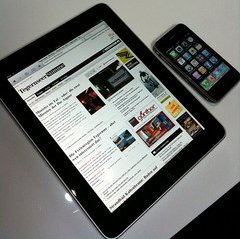 The iPad has become a common sight in many work places, schools, homes and on the street. While Microsoft’s announcement they will enter the tablet category may change this, iPads are a notable element of any PPC strategy.
The iPad has become a common sight in many work places, schools, homes and on the street. While Microsoft’s announcement they will enter the tablet category may change this, iPads are a notable element of any PPC strategy.
This device is a multi-headed beast – and that’s something you need to take into account when setting an iPad strategy, and reporting performance.
iPad Usage Through The Working Day
Based on data we’ve seen, early morning iPad usage is essentially a hybrid of a laptop and a newspaper – used to browse news, check email and calendars, and “dip in” to the web in a relaxed way. There’s some search involved – but it’s limited, and unlikely to lead to an immediate conversion on most occasions.
As commuters head off to work, the above continues, but with searches increasing in volume. At this point, the iPad transforms – usage patterns are more like that seen on smartphones than on laptops. Peak iPad usage occurs around 8 a.m., according to comScore.
Usage then declines as iPads are left in bags while workers use desktop devices. Some iPad usage occurs for business purposes, but its impact on search volumes is minimal. The multi-headed beast is dozing; my comparison PC usage for web growing peaks at 9 a.m. and declines through the day.
Then, around 4 p.m., a more spread-out commuting period begins, and the iPad comes back into play. Again, comScore data backs this up.
Traffic starts to climb, firstly as the iPad is used again in a similar way to a mobile and as commuters settle in at home, it replaces the laptop, with activity peaking around 10 p.m. This is a role it holds on weekends, too.
PPC Strategy for iPads
So, practically, what does this mean when executing PPC campaigns with regards to the iPad? Everybody knows you should set up and manage separate iPad campaigns – the above data, even if a generalization, underlines this.
Managing expectations and educating colleagues is important. It’s easy to lump mobile and tablets together – and set KPIs and expectations across them both. This won’t work.
Tablet users behave differently than mobile users. Therefore, they need different, but aligned, strategies. For many brands, mobile users are researchers who then convert later; breaking conversion tracking and making the mobile channel look like it has a low ROI.
Set different KPIs for tablets. They can bring in sales – but this isn’t their only purpose; they also generate researchers who might convert elsewhere.
The differences in behavior at different times of day require consideration too. Should you:
- Set your bid strategy to increase bids in the evening?
- Bid lower during the morning and daytime?
- Try to attract those researchers, and justify the spend through attribution and understanding how they convert into customers on their tablets later in the day/week/month?
Copy requires consideration, too. Should you:
- Include text that clearly shows your site works on an iPad?
- Link to the site, or an iPad app?
The site needs to work well on an iPad – all the way to conversion; that’s crucial. Some sites work well on the homepage and one or two levels into the site, but don’t work when the consumer tries to buy or fail when processing a payment.
Digital Omnivores
The iPad isn’t the only device increasing its share of web traffic – comScore’s data shows non-computer traffic rising month-on-month.
While iPads now account for 40 percent of that, games consoles, e-readers and mobiles are also growing in usage. If your site’s analytics shows you’re receiving traffic from them, you need to consider how consumer usage patterns on them too – and adjust your strategy accordingly.
The impact of multiple devices and consumers who skip between them – what comScore calls “Digital Omnivores” – is only just starting on PPC.
Image Credit: oliverlindner/Flickr
 The iPad has become a common sight in many work places, schools, homes and on the street. While
The iPad has become a common sight in many work places, schools, homes and on the street. While